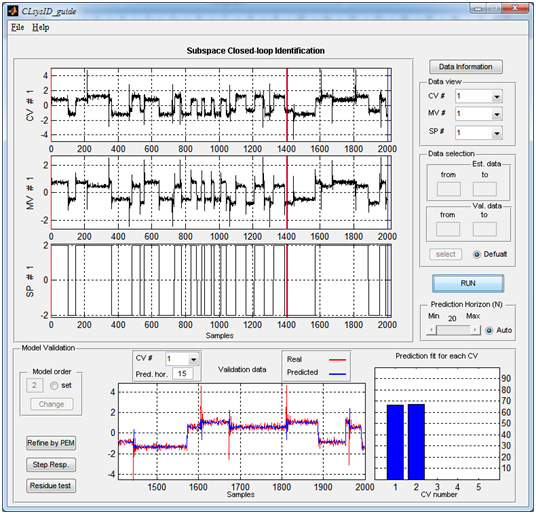
Menu:
Closed-Loop Subspace System Identification

The closed-loop subspace system identification (CLsysID) programme uses a data-driven system identification approach to identifying chemical processes using closed-loop operating data from univariate and multivariate processes. Subspace identification methods provide an alternative approach to the classical system identification methods such as the prediction error method (Ljung, 1999) and the instrument variable method (Söderström & Stoica, 1989). Subspace methods use efficient computational algorithms such as QR-factorisation or singular value decomposition (SVD), which makes them more numerically robust than the traditional approaches. Most subspace identification methods have been extended to deal with closed-loop system identification. A closed-loop subspace identification method was proposed in (Danesh Pour, Huang, & Shah, 2008) based on a joint input-output identification approach. An alternative formulation of this method with guaranteed consistency is described in (Huang & Kadali, 2008). The software is based on this algorithm.
The algorithm used by programme can be stated in the following steps:
- Obtain closed-loop operating data without setpoint changes and the process time delays.
- Form the subspace equations and determine which matrices are to be estimated.
- Construct corresponding matrices with known data set.
- Estimate the subspace matrices and the input noise covariance matrix using the closed-loop subspace matrices and the joint input-output framework.
Manual
The manual for using the toolbox can be found here.
System Requirements
This programme has the following prerequisites:
- Windows XP or newer.
- MATLAB® 2006a or newer. There may be issues with more recent (MATLAB® 2009a or newer) version of MATLAB®. The programme has not been tested on older versions of MATLAB®.
- System Identification Toolbox from MATLAB®.
Download
The files can be downloaded from the Downloads section.
Developers
This software has been developed by the following people:
- Nima Danesh Pour,
- Biao Huang,
- Sirish Shah, and
- Yu Zhao.
References
- Nima Danesh Pour, Biao Huang, and Sirish L. Shah (2009). “Consistency of noise covariance estimation in joint input–output closed-loop subspace identification with application in LQG benchmarking” in Journal of Process Control, Volume 19, pp. 1649-1657. doi: 10.1016/j.jprocont.2009.10.005
- Biao Huang and Ramesh Kadali (2008). Dynamic Modeling, Predictive Control and Performance Monitoring: A Data-driven Subspace Approach. Springer Verlag, ISBN: 978-1-84800-232-6
- Lennart Ljung (1999). System Identification Theory for the User. Upper Saddle River, New Jersey, United States of America: Prentice Hall PTR. ISBN: 9780136566953
- Söderström, Torsten and Petre Stoica (1989). System Identification. New York, New York, United States of America: Prentice Hall.ISBN: 0-13-881236-5